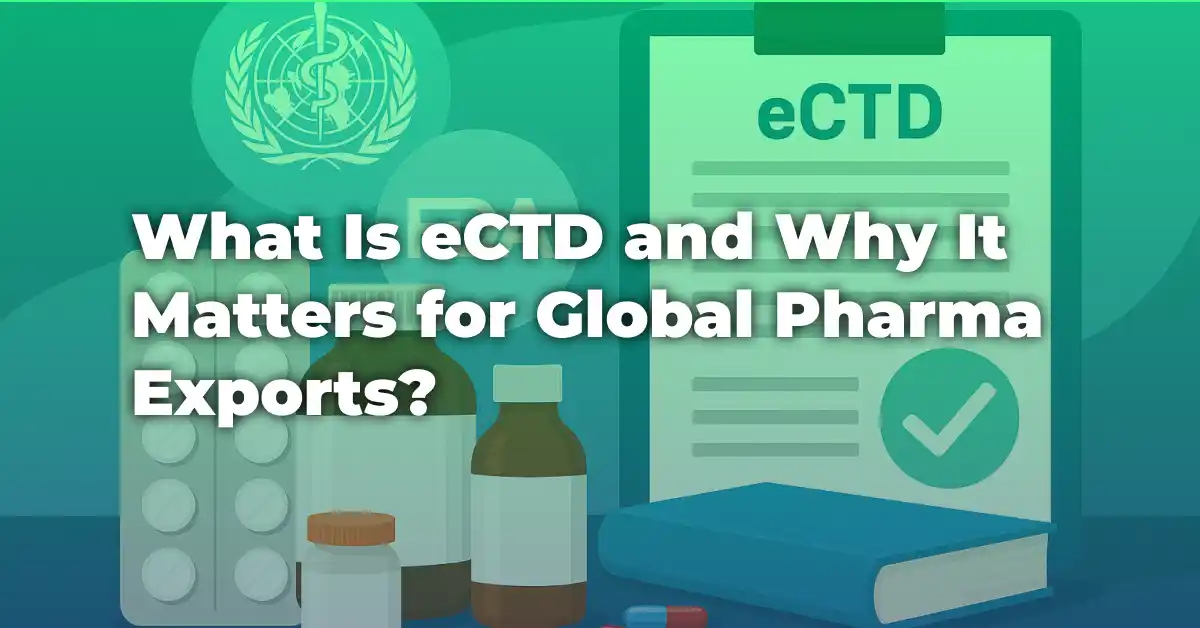Not Just in Drug-It’s in that Data
A great formulation does not suffice for exporting pharmaceutical products. Clean, compliant documentation is needed—and that is where it gets complicated.
For those who have been in the industry long enough, they would have most probably encountered the term eCTD in relation to regulatory conversations. So what really is eCTD? More importantly, eCTD, and why it matters when it comes to global pharma exports are things every exporter, regulatory professional, and pharma brand needs to know.
Let’s break it down in simple English.
Exactly What Is eCTD?
Common Technical Document electronically: eCTD. A standardized format applies whenever information should be submitted to a regulatory authority, such as the FDA (U.S.), EMA (Europe), or Health Canada, as part of an application for a new drug, generic, or export approval.
Includes:
- Details on products
- Clinical trials
- Manufacturing protocols
- Studies on stability…
- A complete application concerning the regulation-digital layout submission.
The first basic understanding of the eCTD is why it matters in global pharma exports by holding the realization that regulators expect consistent and digital readiness. eCTD enables that.
Why eCTD Matters So Much in Global Pharma?
Now let’s plunge into the why. These are further things about why eCTD is a big deal:
Regulatory acceptance: An important part of almost all major drug authorities mandates the use of eCTD for submissions. In other words, if you prefer paper-based submissions or just non-standard submissions, expect a lot of delays or few chances of approval.
Speedier approvals: eCTD submissions speed up the way agencies assess your application. With a digital structure, they can search, validate, and respond faster-sometimes saving weeks (even months) off your approval process.
Fewer Errors and Redundancy: Since eCTD employs modules with a centralized framework, there is less chance of duplicated data input and it also assists maintaining version control-these are two of the major pain points in traditional pharma documentation.
That is why what is eCTD and its importance in global pharma exports is a strategic one rather than regulatory. That is non-negotiable if you perhaps want to grow globally.
eCTD Is Not Only for Big Pharma.
Most small to medium-sized companies believe that eCTD is an exclusive advantage that only the big guys can have. This is not a true statement.
In fact, a majority of other countries like India, Saudi Arabia, and the ASEAN nations have begun to implement the use of eCTD formats in some parts of their submission processes. So, whether you are exporting finished formulations, APIs, or licensing products abroad, eCTD
could be your ticket to a smoother process.
The sooner you adapt, the better positioned you will be for global partnerships and tenders.
Getting Acquainted with eCTD (Without the Madness)
It sounds extremely technical, but can greatly be approached step-by-step-it does not make it an impossible task.
Here are the things that help:
Bring a regulatory consultant or eCTD publishing expert on board
Pick a trustworthy eCTD software platform that conforms to your region’s regulatory requirements
Commence early migrating legacy data
Build internal SOP for document versioning and digital compliance
Think beyond a system that works for just one market-every market.
eCTD = Smarter Pharma, Smoother Exports
So there it is, eCTD-and what it means to global pharma exports boils down to: It isn’t just a digital document. It is your passage to global markets.
As international standards tighten and competition grows, having a clear, compliant, and organized regulatory submission process will distinguish you from the authorities, and partners and buyers too.
Contact Us : https://paxterlifesciences.com/
Follow Us : https://www.instagram.com/paxter_lifesciences/






